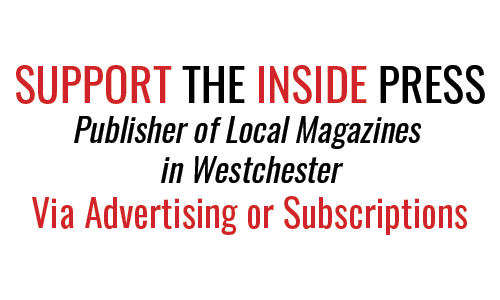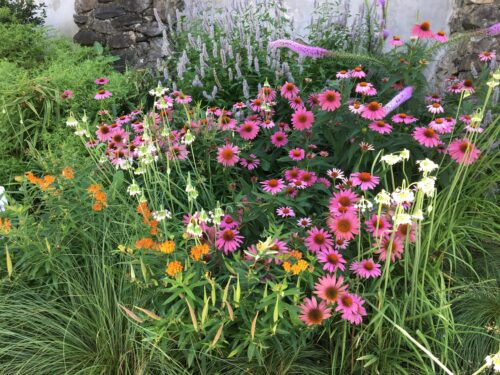
Article and Photos by Missy Fabel
Just last year at a meeting of the Earthwatch Institute, a prominent environmental non-profit, scientists declared the bee to be the most important living being on the planet. This notion was shared by Albert Einstein more than a century ago who boldly stated that “if bees disappear, humans would have four years to live.” Yet bees are at risk of extinction. In fact, in some regions of the world, they have disappeared up to 90 percent.
While that news is sobering, local residents and county-wide initiatives are doing their part to keep bees and other pollinators happily buzzing in the communities of Northern Westchester.
Bees, butterflies, birds and even bats are all pollinators that play a vital role in the transfer of pollen from one plant to another, enabling fertilization and the production of fruit and seeds. More than 30% of our food grows as a result of pollinators. Yet, the habitat loss of native plants and widespread use of pesticides and herbicides are causing worldwide decline of pollinators.
The History Behind the First Pollinator Pathway
Sarah Bergman started the very first Pollinator Pathway in Seattle more than a decade ago as part of a social and ecological project to combat the decline in pollinators. In an effort to connect two green spaces more than a mile apart, Ms. Bergman went door to door to the homeowners in-between to create a mile long 12-foot-wide corridor of pollinator friendly gardens, a literal “pathway” to sustain pollinators with pesticide-free habitat and nutrition.
With increasing public awareness of the decline of pollinators, particularly native bees, Bergman’s idea caught on. In 2018, Norwalk, Wilton and Ridgefield together with Hudson to Housatonic Regional Conservation Partnership (H2H) set up the first Pollinator Pathways in Connecticut. Westchester followed their lead and New Castle Pollinator Pathway Coalition (NCPPC) is among the more than 16 municipalities, organizations and hundreds of individuals joining Pollinator Pathways in Westchester.
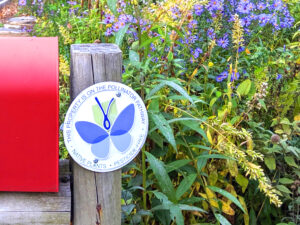
Pollinator Pathways in New Castle
The New Castle Pollinator Pathway Coalition (NCPPC) is a volunteer effort consisting of individuals and organizations that support pollinators by connecting properties and green spaces to create a more hospitable environment for bees, butterflies, birds and other wildlife.
Pollinator Pathway signs have been popping up in New Castle on resident’s mailboxes and downtown near the train station in recent months. These signs mark just some of the properties that are part of the NCCPC.
According to New Castle resident Victoria Alzapiedi, founder of New Castle Healthy Yards and co-chair of NCCPC, more than 130 public and private properties are already on the Pathway and the list is growing. “I’m so excited that there are so many property owners in our community signing on to the New Castle Pollinator Pathway. Not using pesticides and other lawn chemicals and adding native plants–including specific host and nectar plants for each species of butterfly, moth, and bee–will attract these important insects to your yard and provide a haven for them to live and to thrive,” Alzapiedi explained.
Pollinator Friendly Gardens Gain Traction in Other Towns
Garden clubs and other organizations in Pleasantville, Bedford, North Castle and other towns in Westchester are also spreading the word, through education, outreach and the creation of pollinator friendly gardens.
“Our mission includes educating people about ways to help the planet,” says Phina Geiger, president of the Pleasantville Garden Club, whose members planted a demonstration garden next to a playground in Mt. Pleasant this past spring. “Many of the plants we used were ones from our yards, tried and true locally sourced native plants that people may not know about, but can come and see and be inspired to use in their own yards. The Pleasantville Garden club is also partnering with their Parks & Recreation department to promote Pollinator Pathways in other areas of town, she added.
Plans to add native and pollinator friendly plants are also in the works in Armonk. This spring, the North Castle Public Library is adding native trees, shrubs and perennials to its foundation planting as part of the New York Library Association (NYLA) state-wide Sustainable Library Certification Program. “We wanted to enhance the landscaping in front of our library,” says Edie Martimucci, Director of North Castle Public Library, “and using native plants just makes sense from an environmental and sustainability standpoint.”
Tips for Creating a Pollinator Friendly Garden
Whether you live in an apartment with a balcony, a typical suburban home, a large estate or are a commercial business in town, everyone can participate in Pollinator Pathway by avoiding the use of pesticides and choosing native plants. Nature preserves, such as Glazier Arboretum in New Castle, Eugene and Agnes Meyer Preserve in North Castle, town and county parks, schools, typical backyards and front yards, even window boxes can help support pollinators.
“It’s simple, really,” declares Filipine de Hoogland of Westchester Pollinators. “Many people already have native trees and shrubs in their yards with natural pesticide free areas. If we connect our pollinator friendly yards, we can construct pathways. Pathways create safe territory for our pollinators and other wildlife to survive.” She also suggests informing your landscaping company about the steps you are planning to take to create a pollinator friendly yard, so they can help you achieve your goals.
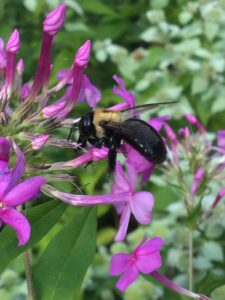
Year-Round Needs for Pollinators
Pollinators need nectar and pollen in all seasons. Native spring flowering trees and shrubs are an important nectar and pollen source early in the season as well as common native plants often considered “weeds,” such as the common violet. Violets provide nectar as well as leafy greens for the recently hatched butterfly larvae of the Great Spangled Fritillary. Consider leaving violets and other wildflowers in your lawn in spring.
Aster and goldenrod are vital sources of both nectar and pollen in the fall. White wood aster naturally colonizes the woodland edges common in suburban landscapes and can easily be encouraged to spread. Leaving some leaf litter in your garden or natural area also helps support pollinators by providing cover for overwintering insects.
Local Pollinator Events On the Horizon
Look for NCPPC and Westchester Pollinator events this spring and summer, including activities to celebrate the 50th anniversary of Earth Day as well as national Pollinator Week, June 22-28. In addition, mark your calendar for The Chappaqua Garden Club’s Mother’s Day weekend plant sale from May 7-10. The sale offers hundreds of native plants including specific pollinator friendly plant combination kits for sun, shade, wet and dry areas, according to Chappaqua Garden Club co-president Melanie Smith. For more information, visit chappaquagardenclub.com
Missy is a native plant landscape designer and consultant, teacher, writer and naturalist in Chappaqua. She is a Steering Committee member of the Native Plant Center at Westchester Community College, a member of the Town of New Castle Conservation Board and co-chair of the NCPPC.
For more information on Pollinator Pathways and how to start one in your town, visit: https://www.pollinator-pathway.org
How to Join the Pollinator Pathway Initiative
- Include native plants on your property for all seasons
- Avoid using pesticides and herbicides
- Consider leaving some bare ground for nesting native bees and leaving some autumn leaves for overwintering eggs and pupae of pollinating insects
If you reside in New Castle, register at: pollinator-pathway.org/new-castle
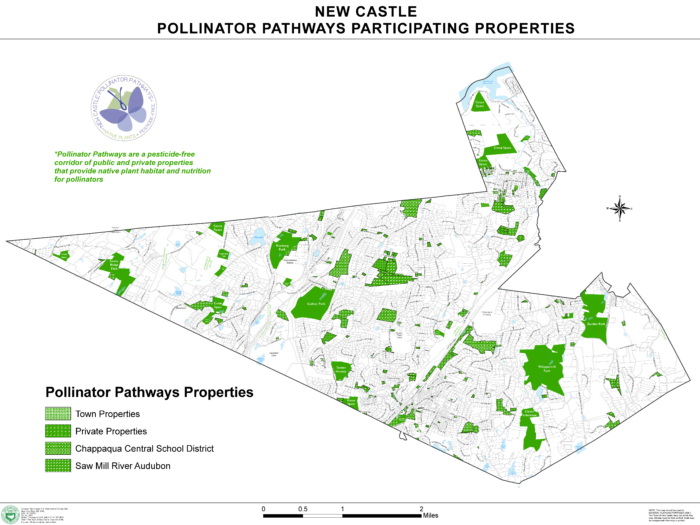
Why are Pollinators Under Threat?
- Habitat loss due to urban development and agriculture
- Widespread application of pesticides
- Climate change
